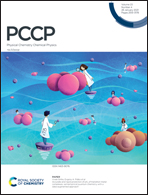Geometric and electronic properties of AulPtm (l + m ≤ 10) clusters: a first-principles study
Abstract
The structural evolutions and electronic properties of AulPtm (l + m ≤ 10) clusters are investigated by using the first-principles methods. We use the inverse design of materials using the multi-objective differential evolution (IM2ODE) package to globally search the equilibrium structures and investigate the evolving trend from a two-dimensional structure to a three-dimensional structure on horizontal extension and vertical extension for AulPtm (l + m ≤ 10) clusters. The three-dimensional stable geometry of Au8Pt and Au8Pt2 is discovered for the first time in our work. We also notice that the equilibrium structures of AulPtm (l + m = 10 and l ≤ 8) tend to form a tetrahedral geometry and can be obtained by replacing the Au atom in the most stable structure of Aul+1Ptm−1 with the Pt atom, where Pt atoms assemble together and occupy the center of clusters and Au atoms prefer to lie on the vertex or edge position. The average binding energy (Eb) is mostly decided by Pt–Pt bond numbers, namely the numbers of Pt atoms, followed by Au–Pt bond numbers. The second-order energy difference (Δ2Ev and Δ2Eh) and the nearest-neighbor energy difference (Δ4Enn) show that Au6Pt, Au4Pt2, Au3Pt3, Au2Pt4 and AuPt7 clusters exhibit high relative physical stability, so we suggest that these clusters could be defined as the magic number clusters for AulPtm (l + m ≤ 10) clusters. The HOMO–LUMO energy gap (Eg), adiabatic ionization potential (AIP) and the adiabatic electron affinity (AEA) are also investigated to elaborate the relative electronic stability of all the clusters.



 Please wait while we load your content...
Please wait while we load your content...